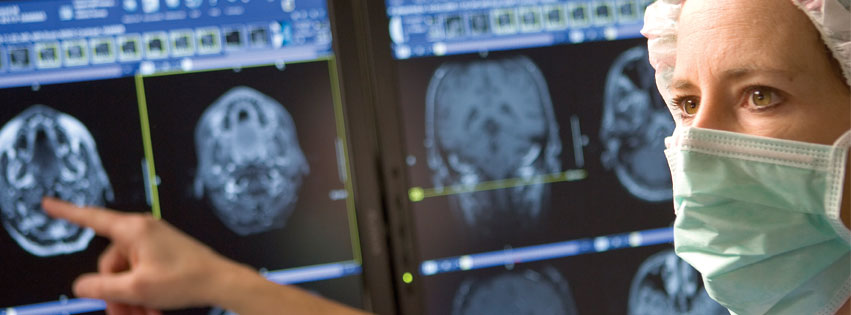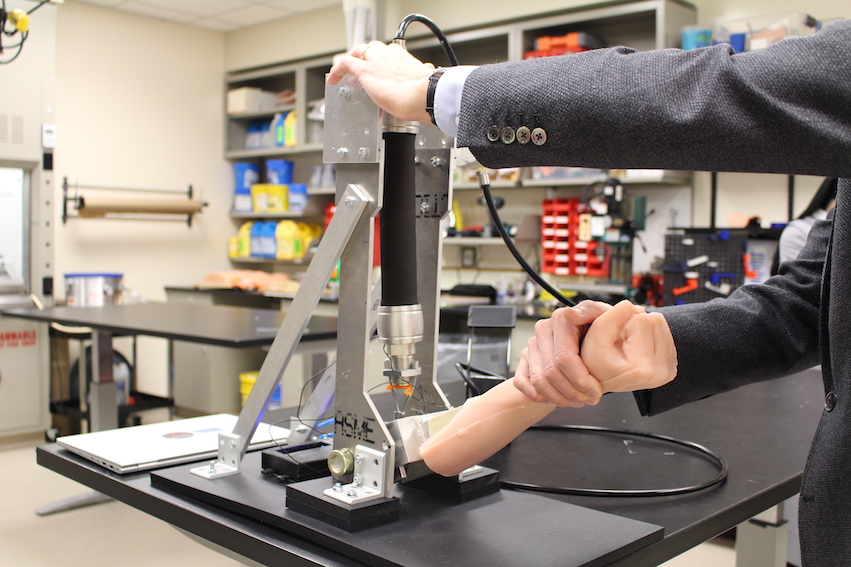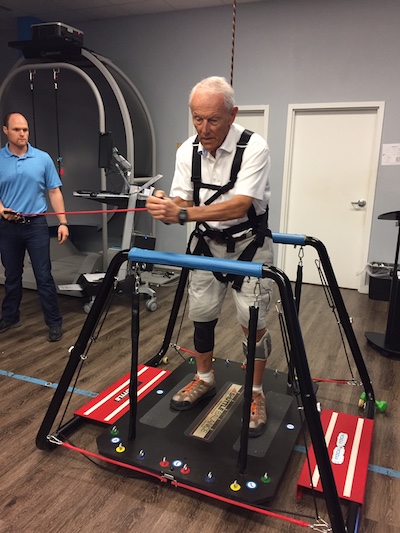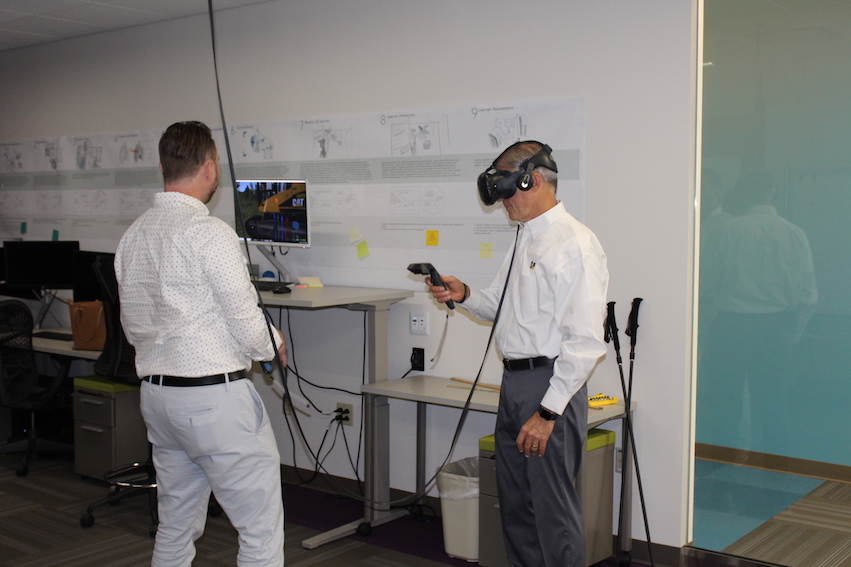
Through the work of two retired Caterpillar executives, area residents suffering from neurodegenerative disorders are benefiting from investments in research and tools that improve quality of life.
It’s projected that more than 12 million Americans—nearly one in 25—will suffer from a neurodegenerative disorder such as multiple sclerosis (MS), Lou Gehrig’s disease (ALS), Parkinson’s or dementia within the next 30 years. These diseases have lasting effects, not only for patients who live with the condition, gradually losing their physical or mental capabilities, but also the caregivers and family members who suffer emotionally and financially.
“Some studies argue that neurological conditions cause the greatest effect on lost ‘quality-of-life years’ compared to non-neurological conditions,” says Dr. Chris Zallek, neuromuscular disorders specialist with OSF HealthCare Illinois Neurological Institute (INI). “One reason neurological conditions seem so common and are increasingly present in the population is because our population is aging.” It’s a national epidemic with a significant local connection.
In collaboration with the University of Illinois College of Medicine Peoria (UICOMP), health professionals at OSF IN are making major strides in research to help detect and diagnose patients earlier, thus helping them manage the effects of their disease for a better quality of life. But research requires investment.
Two retired Caterpillar executives—both diagnosed with neurological disorders—have been on the frontlines of advocacy, raising money and awareness for their related causes. First diagnosed with MS more than 40 years ago, Larry Wallden reorganized the local MS Council to ensure that local funding stayed in central Illinois, while Ed Rapp, diagnosed with ALS in 2015, founded the Stay Strong vs. ALS charitable fund to find a cure and bring assistive technologies to others suffering from the disease. Their work—and that of many others—has been instrumental in putting Peoria on the map for neuroscience innovations and the treatment of neurodegenerative disorders.

This strength exam simulator at the Jump Simulation Center was developed to allow students to more easily identify strength changes in actual patients, leading to earlier diagnoses of neurological conditions such as ALS.
Creating a Village
Larry Wallden spent most of his Caterpillar career living outside the U.S. In fact, he and his family lived on five different continents during his tenure with the company as a marketing executive. When he was first diagnosed with MS, he was living in Geneva, Switzerland. It was 1977, and he’d noticed a tingling sensation in his face and arms. He was able to manage the disease for years with few complications, but in 1998, his wife noticed he was limping. After a series of tests with neurologists in Singapore and the U.S., it was determined his MS was progressing.
By the time Wallden retired from Caterpillar in 2001, the disease had affected the entire left side of his body. “I was at a golf tournament and I was limping pretty badly,” he recalls. “One of my friends asked what was wrong… and I told him I had MS. Mike O’Brien, who was president of the MS Council at the time, overheard this. We started talking and he asked if I’d like to join the MS Council.”
After attending a couple meetings, Wallden was disappointed to learn that all of the money raised locally ended up going to the National MS Society, so he decided to change that. “I put together a group of retired Cat guys with experience running a business unit to come up with a strategy to increase the quality of life for those living with MS,” he explains. “I wanted Peoria to have one of the best MS centers in the country for diagnosis, treatment, education, research and family care.”
The group met regularly for six weeks devising a business plan, including a mission, vision, goals and critical success factors. Their first fundraiser netted $14,000, which was quite remarkable at the time. But as Wallden learned, much more had to be done. “After meeting with doctors, it was determined that each patient incurs around $24,000 to $30,000 a year in indirect costs,” he says, noting the high cost of insurance and copays, physical therapy, counseling, equipment and the like. “No one knew anything about the costs of living with MS.”
Besides raising funds and awareness, Peoria’s MS Council established a relationship with the OSF HealthCare Foundation to make sure the money got where it needed to go without excessive bureaucratic red tape. “Over the years, we brought more people in and created a village—an INI MS advisory board,” Wallden says. “We looked at what other centers around the country were doing to get best practices [in research, early detection and improved treatment] and bring them back here.” The MS Center at OSF INI goes beyond diagnosis and treatment, providing therapy and social services for the total well-being of patients and their families.

Upon consulting with several area healthcare leaders—including Dr. Sara Rusch, UICOMP regional dean, and Dr. Carl Asche, director of the Center for Outcomes Research at UICOMP, among others—it was clear Peoria needed to be on the frontlines of research in order to have a national presence. “We provide money to the INI and UICOMP so research papers on MS can be written and published,” Wallden explains. “Then the Jump [Simulation] Center came on board to collect data. They can simulate MS data into predictability rather than relying on a book. Now the INI, UICOMP and the MS Center are all on board, and we can leverage this partnership to help more people.”
One of the most beneficial outcomes of this collaborative effort has been the development of the MS Flowsheet Registry, a customized database giving clinicians quick and easy access to the treatments and prognoses of MS patients. According to Dr. Asche, “The UICOMP Center for Outcomes Research (COR) is collaborating with INI clinicians, INI residents, other INI staff and UICOMP students on projects involving the use of the MS Flowsheet Registry to assist Dr. Zallek and others in the development of tools to better manage the diagnosis and care of MS patients.” The ability to share this information not only helps the cause of MS research, it provides insight for other neurological disorders as well.
Big Donors = Big Impact
Last fall, Ed Rapp, a former Caterpillar group president suffering from ALS, and his wife Ann made a $1 million donation to the OSF HealthCare Foundation to fund neuroscience innovations—including assistive technologies, improved access to care, and aid for earlier diagnoses of neurological conditions. “We have focused our efforts on supporting those in search of a cure, those bringing better assistive technologies to those suffering from the disease, and supporting ALS efforts in our hometowns of Peoria and Raleigh,” Rapp explains.
“The Rapps have requested that efforts go toward developing and improving assistive devices for patients with ALS—in particular, communication assistive devices,” Dr. Zallek explains. Jump ARCHES (Applied Research for Community Health through Engineering and Simulation), which brings clinicians and engineers together to develop innovative solutions to healthcare problems, is an ideal candidate for this funding.
“As part of Jump’s request for proposals for projects, research teams throughout the University of Illinois System may collaborate and propose to pursue ideas for this challenge,” Dr. Zallek adds. “They identify a problem/challenge area and submit proposals to ARCHES for possible funding support.” Working together at the Jump facility, these teams hypothesize, test and redesign tools, techniques and processes being used by caregivers every day.
“The endowment can support those efforts and other projects that impact the evaluation and care of patients with ALS and other neurological conditions,” he says. “Currently, through Jump ARCHES, we are building neuro exam simulators and tools to measure parts of the neurological exam to test muscle stiffness and muscle strength.”
It’s an exciting time to be in the field. The science is advancing rapidly, Dr. Zallek adds, and genetic therapies are being developed for those with neuromuscular disorders. “Research continues to be very expensive,” he notes. “But the amount of information gathered is increasing in value per dollar spent in new biotechnologies and the ability to focus and experiment more rapidly.”

Virtual reality technologies are useful in therapy to study how patients perform tasks in various settings. Here, Ed Rapp tries out the technology.
At the same time, a growing shortage of neurologists poses a formidable challenge. As such, Dr. Zallek is focused on developing tools to train and clinically assist non-neurologists—other doctors and medical professionals working with neurological patients. “Only 1.5 percent of U.S. medical school grads go on to specialize in neurology as students perceive other medical fields as more attractive,” he explains, pointing to several reasons for this crisis, including a high burnout rate, the retirement of established neurologists, and greater demand for services due to an aging population.
But with all the advances being made, Dr. Zallek is hopeful that students at UICOMP will take a greater interest in studying neurological conditions. “I wish I was starting my career now,” he adds. “New developments are happening so quickly because of the dedicated research previously performed that is the foundation for new research and technologies.” This rapid progress—in treating disorders previously thought to be untreatable—is happening right here in Peoria.
Living and Learning
Meanwhile, at nearly 80 years old, Larry Wallden has lived with MS for half his life—but he will tell you it’s been a good one. “I stay active and do physical therapy several times a week, so I don’t degenerate,” he says. “There is no cure for MS, so you better do something and work at it.” This philosophy has served him well over the years. Through his work with the MS Council, Wallden has made a substantial impact on local MS patients—and he isn’t finished yet. He may not have chosen this path in life, but it has become his calling. iBi
Read "Staying Strong with ALS" to learn more about Ed and Ann Rapp's efforts to find more effective treatment options—and ultimately, a cure—for ALS.

